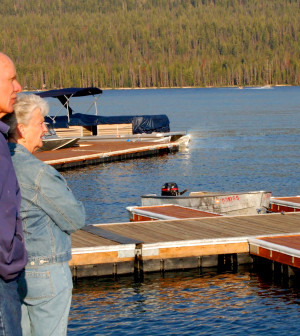- Navigating Your Midlife Crisis: Embracing New Possibilities
- City Raccoons Showing Signs of Domestication
- Mapping the Exposome: Science Broadens Focus to Environmental Disease Triggers
- One Week Less on Social Media Linked to Better Mental Health
- Your Brain Changes in Stages as You Age, Study Finds
- Some Suicide Victims Show No Typical Warning Signs, Study Finds
- ByHeart Formula Faces Lawsuits After Babies Sickened With Botulism
- Switch to Vegan Diet Could Cut Your Greenhouse Gas Emissions in Half
- Regular Bedtime Does Wonders for Blood Pressure
- Dining Alone Could Mean Worse Nutrition for Seniors
Better Way to Treat Seniors’ Ankle Fractures?

A new type of plaster cast might help older adults avoid surgery for unstable ankle fractures, researchers say.
“Older adults — those over 60 — are suffering an increasing number of ankle fractures from leading more active lifestyles and the rising prevalence of osteoporosis,” said study author Keith Willett.
“However, we know that older patients have disproportionately poor outcomes, and their quality of life can suffer as they lose mobility,” added Willett. He is a professor of orthopedics, rheumatology and musculoskeletal sciences at the University of Oxford in England.
Currently, two techniques are used to treat unstable ankle fractures: surgery to set and fix the bones using plates and screws; or a traditional plaster cast.
“Each technique has drawbacks,” Willett said in a university news release. “Traditional plaster casts are associated with misaligned bones, poor healing and plaster sores. Surgery, especially in older people, is often complicated by poor implant fixation, wound healing problems and infection.”
Willett and his colleagues assessed the use of a new plaster cast technique called “close contact casting.” This uses less padding than a traditional cast and sets the bones by being a close anatomical fit. The cast is applied by a surgeon while the patient is under anesthetic.
The study included 620 older adults in the United Kingdom with unstable ankle fractures. All would normally have had surgery. Instead, half had surgery and half received a close contact cast.
Six weeks and six months after treatment, there were no significant differences between the two groups in terms of pain, ankle motion, mobility or quality of life, the study found.
Patients in the surgery group had more adverse events than those in the close contact cast group — 116 versus 71. Also, those in the close contact cast group spent an average of 54 minutes less time in the operating room, but required more outpatient consultations and use of hospital transportation.
The length of hospital stay and the time it took patients to get back on their feet were similar in both groups, according to the study. The results were published Oct. 11 in the Journal of the American Medical Association.
“Overall, this study indicates that close contact casting may be an appropriate treatment for older adults, reducing the level of resources needed for treatment, and avoiding some of the common complications of surgery,” Willett said.
More information
The American Academy of Orthopaedic Surgeons has more on ankle fractures.
Source: HealthDay
Copyright © 2025 HealthDay. All rights reserved.










